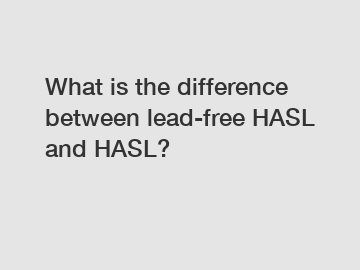What is the difference between lead-free HASL and HASL?
Lead-Free HASL vs. HASL: Understanding the Difference.
In the world of electronic assembly and circuit board manufacturing, there are several surface finish options available. One commonly used surface finish is HASL (Hot Air Solder Leveling), which has been widely used for many years. In recent times, however, lead-free HASL has emerged as an alternative due to increasing environmental concerns. This article aims to provide a clear understanding of the difference between lead-free HASL and HASL, highlighting the advantages and disadvantages of each.
What is HASL?

HASL, or Hot Air Solder Leveling, is a surface finish applied to circuit boards after they have been assembled and soldered. It involves immersing the assembled boards in a molten bath of solder and then using hot air knives to remove the excess solder, leaving behind a uniform coating of solder on the board's surface. This process provides a flat, solder-coated finish, making it suitable for both through-hole and surface mount components. HASL is known for its cost-effectiveness and simplicity, making it a popular choice in the industry.
The Advantages of HASL:
1. Cost-effective: HASL is relatively inexpensive compared to other surface finish options, making it an attractive choice for high-volume production.
2. Wide availability: HASL is widely available and can be easily found at most PCB manufacturing facilities.
3. Good solderability: HASL offers excellent solderability, ensuring the proper flow of solder during the assembly process.
4. Suitable for most applications: HASL is compatible with both through-hole and surface mount components, making it a versatile option for various electronic applications.
The Disadvantages of HASL:
1. Uneven surface: HASL may result in an uneven surface due to the hot air knives used to remove the excess solder, which can impact the performance of certain components.
2. Limited shelf life: HASL has a relatively short shelf life as the exposed solder can oxidize with time, leading to potential solderability issues and reliability concerns.
3. Not environmentally friendly: HASL traditionally uses lead-based solders, which have raised environmental concerns due to the toxicity of lead. This has led to the development of lead-free alternatives.
Introducing Lead-Free HASL:
Lead-free HASL, as the name suggests, is a surface finish option that eliminates the use of lead-based solder. It follows a similar process to HASL but uses lead-free solder instead. Lead-free HASL emerged as a response to stricter environmental regulations, particularly the Restriction of Hazardous Substances (RoHS) directive. It offers an eco-friendly alternative to traditional HASL without compromising on key performance factors.
The Advantages of Lead-Free HASL:
1. Environmentally friendly: The absence of lead in lead-free HASL makes it an environmentally friendly option, compliant with RoHS regulations.
2. Improved thermal resistance: Lead-free HASL offers better thermal resistance compared to traditional HASL, making it suitable for soldering components with higher heat tolerance.
3. Flatter surface finish: Lead-free HASL provides a flatter and more even surface finish compared to HASL, enhancing the performance of delicate components.
4. Longer shelf life: Lead-free HASL exhibits better oxidation resistance, resulting in a longer shelf life and improved solderability over time.
Conclusion:
In summary, both HASL and lead-free HASL have their own advantages and disadvantages. HASL is widely used, cost-effective, and suitable for most applications. However, it may have issues with surface evenness and environmental concerns. Lead-free HASL addresses these concerns while also offering improved thermal resistance, a flatter surface finish, and longer shelf life. When choosing between the two, it is essential to consider the specific requirements of the application.
To learn more about surface finishes and their suitability for your manufacturing needs, please do not hesitate to contact us.
If you want to learn more, please visit our website consumer electronics pcb , consumer electronics pcb , consumer electronics pcb .


